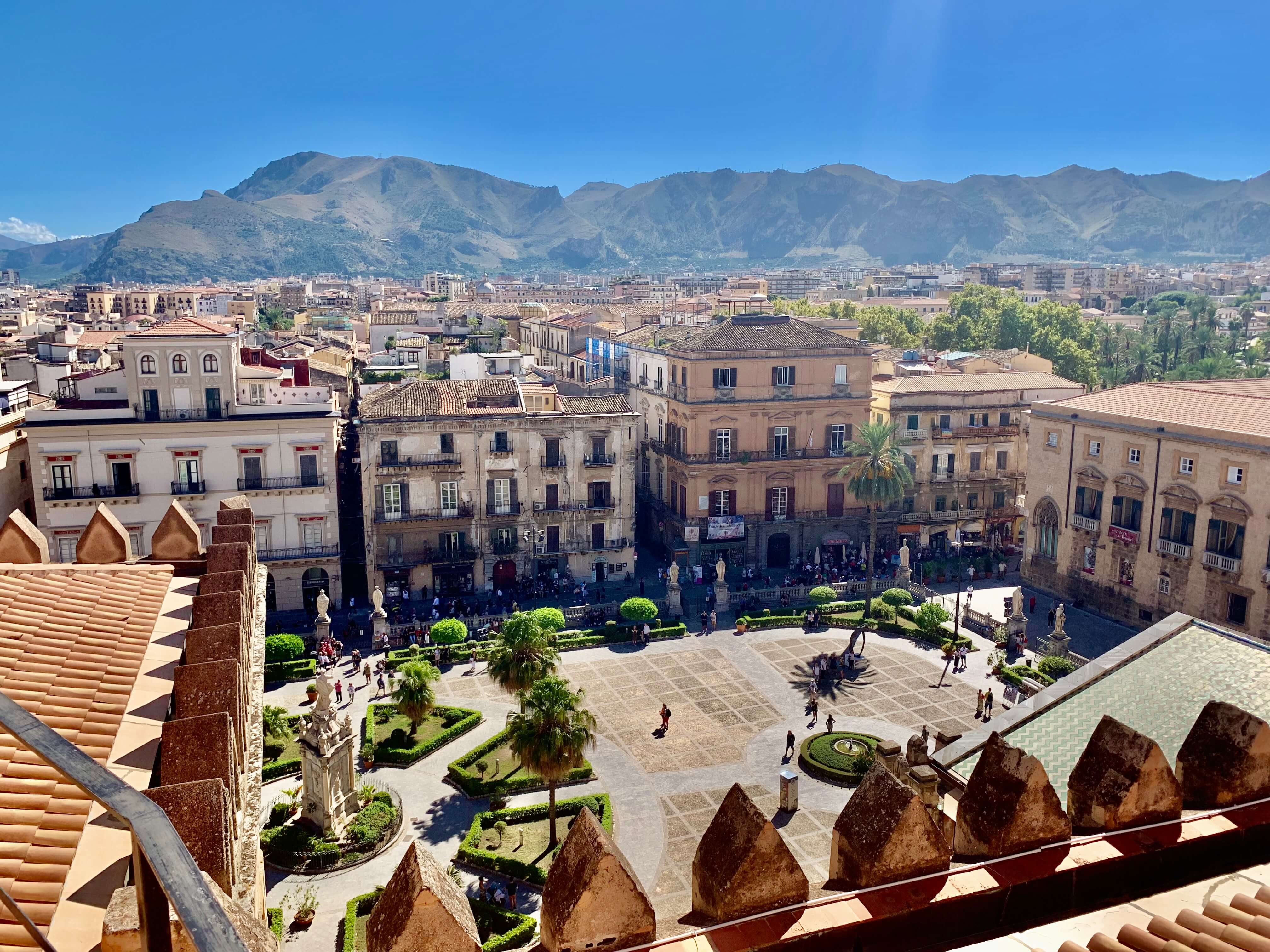- Home
- Things to Do in Sicily
- Ragusa
Things to See and Do in Ragusa Sicily: A Journey through History, Architecture, and Culinary Delights
Ragusa, Sicily is a historic town with a population of 73,000 in the heart of Mediterranean. Its breathtaking beauty, rich history, architectural marvels, and mouthwatering culinary delights will enchant a traveler.
Step back in time as you stroll through Ragusa's ancient streets. The city's stunning baroque architecture will leave you in awe with its unique charm and beauty.
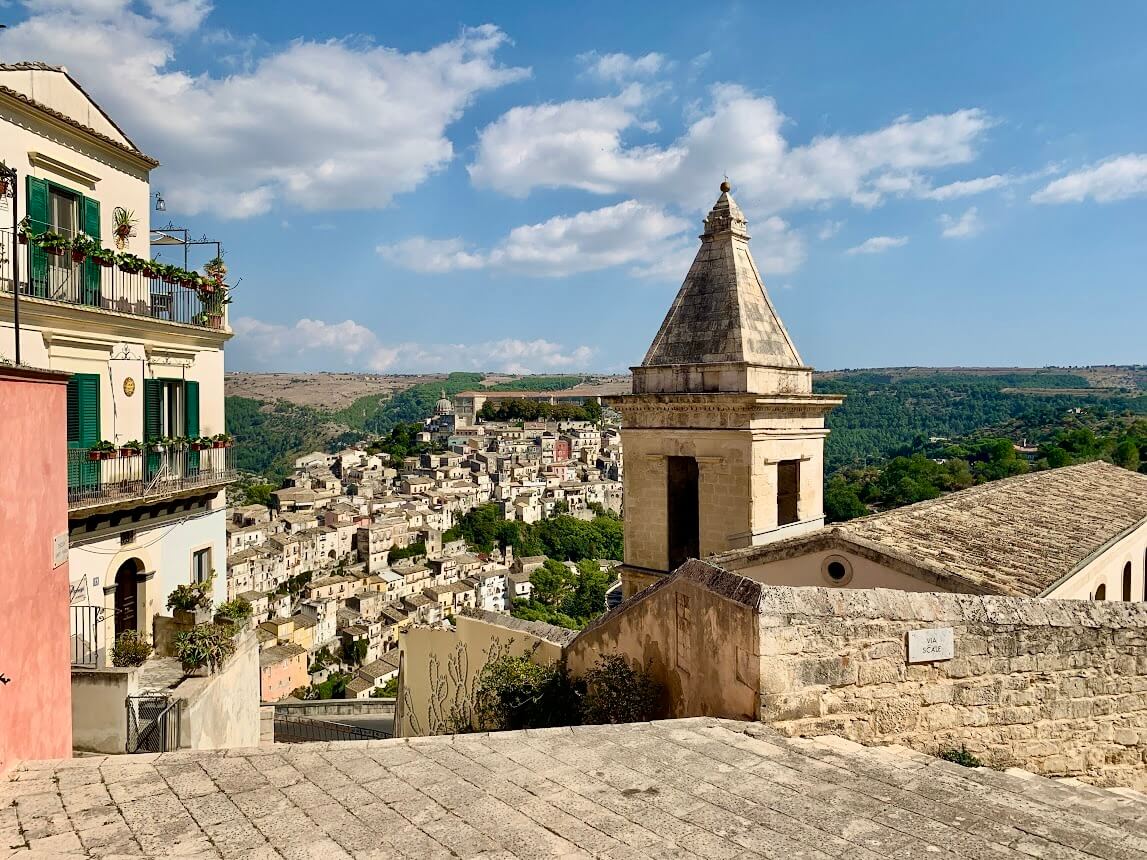 The old town of Ragusa Ibla seen from the new town, Ragusa Superiore.
The old town of Ragusa Ibla seen from the new town, Ragusa Superiore.The Baroque character of Ragusa dates back to the great earthquake of 1693. At that time, much of eastern Sicily was shattered as the earth literally opened before people's eyes. This went on in Ragusa also.
However, from the ashes rose an even more fantastic city, a testament to the resilience and spirit of its people.
From the magnificent Cathedral of San Giorgio to the elegant Palazzo Arezzo, each building in Ragusa Ibla is a masterpiece in its own right. With its promenades, shops, and cafés, the new town of Ragusa Superiore adds its own touch to the city's grandeur.
So let's take a look at this enchanting city, where history, art, and gastronomy intertwine to create some unforgettable things you don't experience anywhere else.
History of Ragusa, Sicily
Ragusa boasts a rich and captivating history spanning centuries. Its origins can be traced back to the 2nd millennium BC when it offered shelter to the original Sicilians - Sicels. This was followed by centuries under Greek, Carthaginian, Roman, Arab, and Norman rule - just like the rest of Sicily.
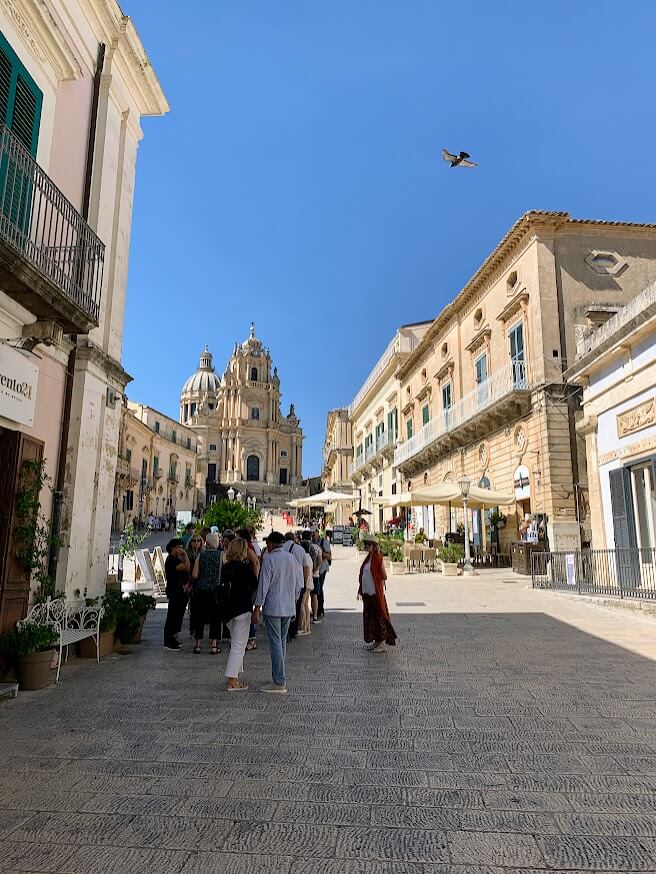 The main church in Ragusa Superiore was also built immediately after the great earthquake. The tower was not built as high as was typical for fear of further quakes.
The main church in Ragusa Superiore was also built immediately after the great earthquake. The tower was not built as high as was typical for fear of further quakes.Ragusa's strategic location, nestled between the rugged mountains and the sparkling Mediterranean Sea, has shaped its history and culture. They have enabled a successful history as the capital of the region.
For much of its history, Ragusa has been a prosperous cosmopolitan town. Its long aristocratic tradition is still visible in the streetscape. Many historical grand palaces, churches, and fortifications still stand today.
The major setback for the town was a massive earthquake in 1693 that destroyed a large part of Eastern Sicily—along with the town of Ragusa. As a result of the earthquake, rebuilding began. Many of the population moved from the old city (Ragusa Ibla) to the new one (Ragusa Superiore).
The city's reconstruction efforts were spearheaded by the renowned architect Rosario Gagliardi, whose masterful designs shaped the Baroque landscape we admire today.
Architecture in Ragusa Sicily
Ragusa's architectural landscape is a true feast for the eyes. The dominant architectural style that defines Ragusa's cityscape is the Baroque, which peaked in the 17th and 18th centuries. This style is characterized by its intricate facades, ornate decorations, and grand, sweeping staircases, all of which can be seen in the iconic Cathedral of San Giorgio.
This famous dragon slayer—St. George, in English—is also the town's patron saint. His cathedral is a magnificent structure towering over the city's historic center.
Part of Baroque's stylistic direction was the idea that buildings should be able to be viewed from many different angles - without compromising their visual impact. In this way, the Cathedral of San Giorgio can - and should - be admired directly from the square in front and from its side streets.
At the same time as St George's Cathedral was built, a church dedicated to John the Baptist was erected on the new side of the town. This church is also worth a visit. It dates from the early 18th century, and has been the seat of the Bishops of Ragusa since the establishment of the diocese in 1950.
You can climb the tower to the spectacular view of Ragusa.
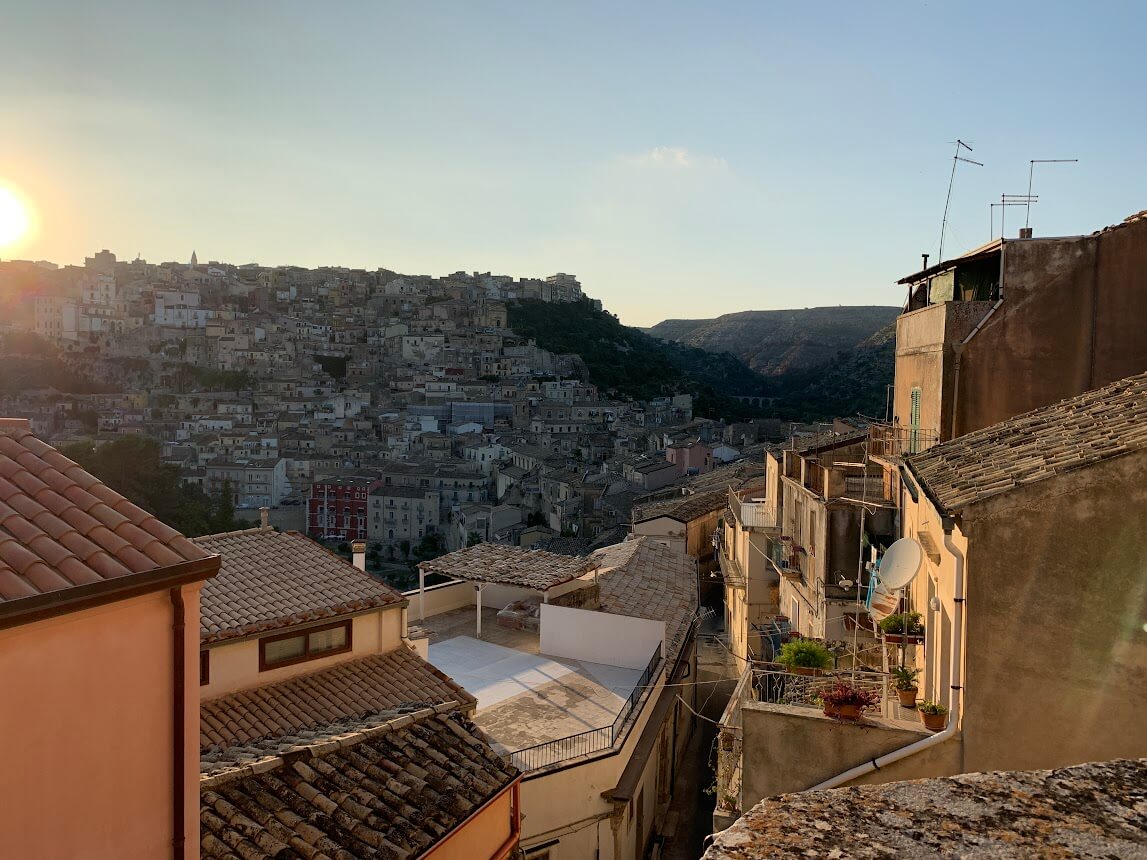 The sun is setting behind Ragusa Superiore, seen here from the old town.
The sun is setting behind Ragusa Superiore, seen here from the old town.Another architectural gem in Ragusa Ibla is the Palazzo Arezzo, a grand 18th-century palace that showcases the city's aristocratic heritage. This magnificent structure boasts a stunning façade with intricate carvings and elegant balconies. The interior is equally impressive, with ornate salons and beautifully preserved frescoes.
The Purgatory Church, in Piazza della Repubblica, is also very nice-looking. You can admire it on a walk from the Old to the New Town—or vice versa. Ragusa in general is best enjoyed on foot.
Exploring Ragusa's UNESCO World Heritage Sites
Ragusa's old town has been recognized as a UNESCO World Heritage Site, a testament to its outstanding universal value. It is also familiar to many from the TV series Inspector Montalbano.
The best way to get to know Ragusa Ibla is to wander aimlessly through its streets. That way, you'll stumble upon numerous other architectural treasures, from the Baroque churches to the charming piazzas and quaint alleyways.
But Ragusa Ibla is not just about its architectural wonders; it's also a vibrant hub of cultural activity. And the numerous cafes and restaurants serve up delectable Sicilian cuisine that will tickle your taste buds.
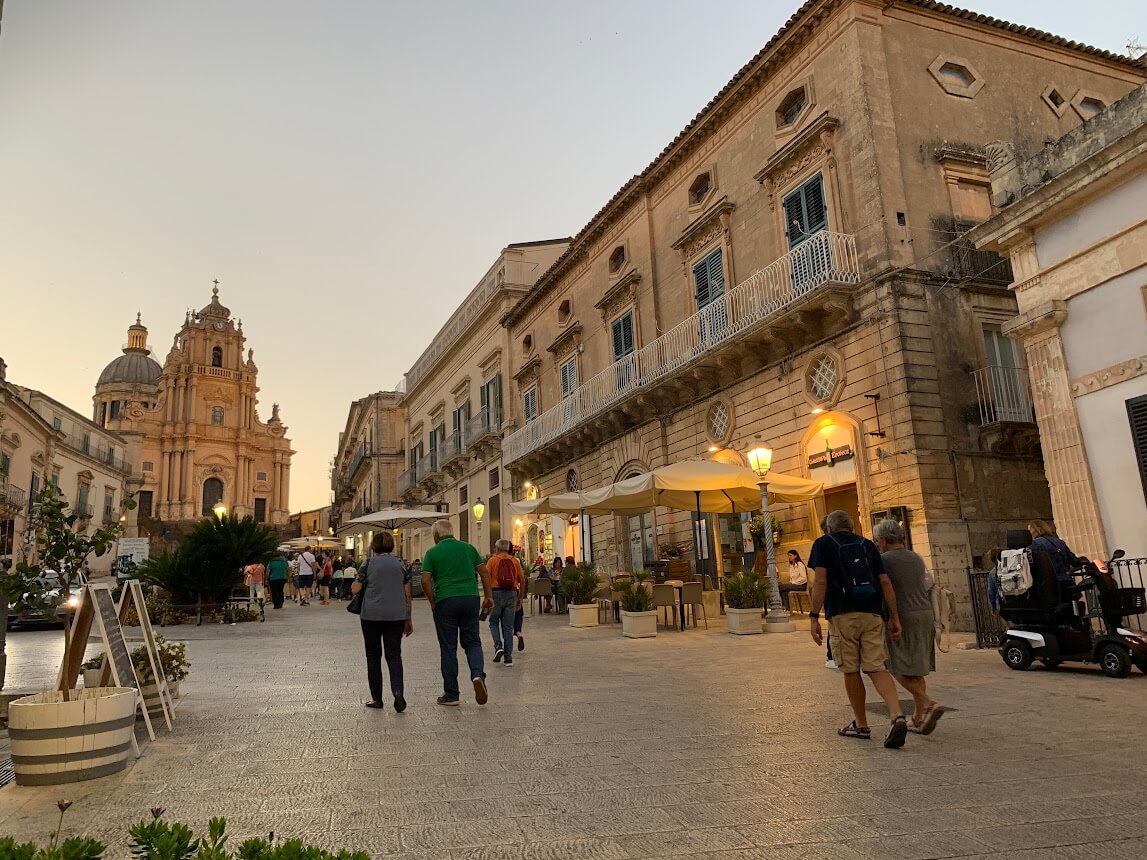 Piazza Duomo and its surroundings have many restaurants, cafés, and small boutiques.
Piazza Duomo and its surroundings have many restaurants, cafés, and small boutiques.Culinary Delights of Ragusa Sicily
Sicily's bountiful natural resources are at the heart of Ragusa's culinary identity. The surrounding countryside, with its rolling hills and fertile valleys, provides an abundance of fresh produce, from ripe tomatoes and fragrant herbs to succulent meats and seafood plucked straight from the nearby waters.
As you wander along Ragusa's charming streets, you'll be tempted by the tantalizing aromas wafting from the city's many restaurants and cafes.
One of the more upscale restaurants is called Duomo. This Michelin-starred establishment has become a beacon of gastronomic excellence in the region. As the name suggests, the Duomo is in Piazza Duomo, in front of San Giorgio Cathedral.
On the more casual side - but not necessary any lesser in taste - I'd recommend a visit to Cantunera Ibla, near Giardino Ibleo. They serve absolutely delicious arancinos, cannolos, and local lemonades. Just their list of different kinds of arancini is mind boggling.
Beer lovers should head to the Lucernaio Pub, which serves products from local microbreweries. It is on a side street between Duomo and Cantunera.
More Attractions In and Around Ragusa
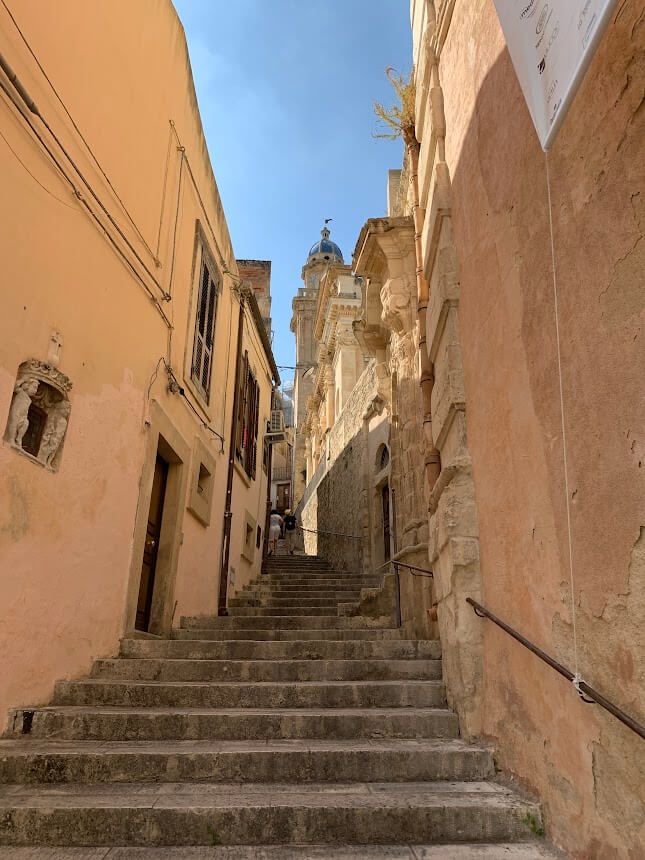 Ragusa's old town is a maze of beautiful small alleys and streets. There's lots to be found by just wandering around.
Ragusa's old town is a maze of beautiful small alleys and streets. There's lots to be found by just wandering around.Ragusa captivates the senses, from its breathtaking architecture to its vibrant culture. You'll discover many inspiring attractions as you explore this enchanting Sicilian gem.
The sights of Ibla are easy to get around on foot - assuming you are in average physical condition.
The footpath between Ibla and Superiore is recommended. Along the way, there are several churches and stunning views of the historic center from the edge of the new town.
In Ibla, you'll find small shops and restaurants on the walk from the Public Gardens to the Church of San Giorgio.
In Ragusa Superiore, the area around the Church of St John the Baptist is where cafés, shops, restaurants, and bars are located.
Ragusa is also well connected to the nearby smaller baroque towns, Noto and Modica. The Marina di Ragusa, in turn, offers an excellent opportunity for a beach holiday.
Accommodation Options in Ragusa
Regarding accommodation, you must choose between Ragusa Ibla and Ragusa Superiore. Both offer plenty of accommodation options.
Most people choose Ibla, as it is close to the main attractions and more attractive as an area.
There are two car parks on the old side: one near Piazza della Repubblica and the other next to the Public Gardens. It is worth asking the accommodation for advice on where to leave your car.
Parking is more accessible on Superiore. Train and bus stations are also located on the new side of town, making connecting to them more manageable.
On the other hand, the journey to the old town is a long walk away. Alternatively, you can take a local bus. The bus rides regularly and takes 20-30 minutes between the city's two parts.
Planning Your Trip to Ragusa Sicily - Transportation and Logistics
If you arrive in Ragusa by public transport, you will almost certainly come via Catania. Buses run through Catania between Sicily's main cities and Ragusa. You can also reach Syracuse by train, which takes about 2 hours.
The most effortless public transport is to Modica, where there is a bus every hour. The journey takes 25 minutes. Daily buses also run to and from the third famous baroque city, Noto. The trip takes two and a half hours.
You can also take a bus to Marina di Ragusa if you fancy a beach holiday. It's a charming place with good beaches and other facilities. If you like the beach life, it's also an excellent place to stay longer.
The drive to Marina di Ragusa takes about half an hour. The bus costs just a couple of euros. The taxi costs around 50-70 euros.
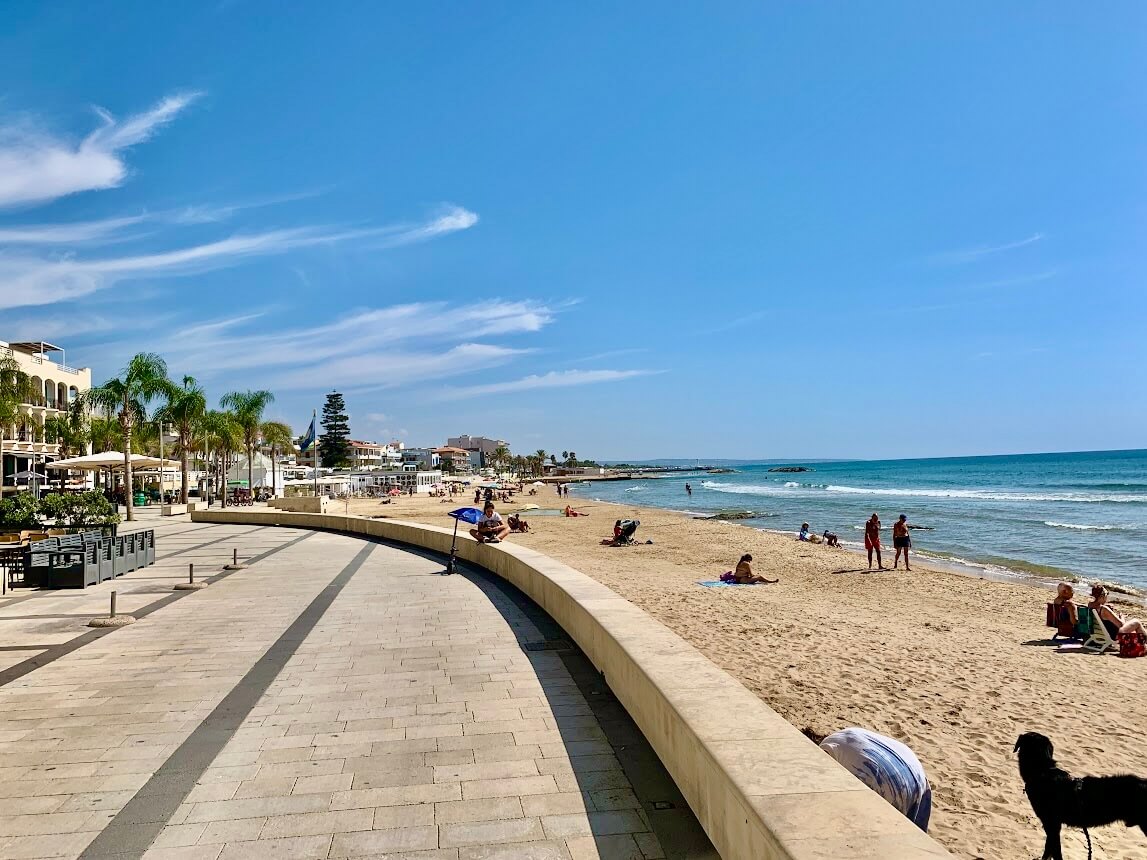 Marina di Ragusa has a lovely beach with good vibes.
Marina di Ragusa has a lovely beach with good vibes.Conclusion
Ragusa is one of the must-visit destinations in Sicily. The town is beautiful and welcoming. Its location has ensured an influx of wealth into the city, which is still seen today.
Walking the streets of Ragusa, you will easily immerse yourself in the region's thousands-year-old history. At the same time, the feeling is strangely light and timeless.
You can visit Ragusa's main attractions in a day or spend several days there. Ragusa is also a good base for exploring the nearby Baroque towns of Modica and Noto.
Ragusa's beach, Marina di Ragusa, is nearby, offering opportunities for a relaxed beach life.
Whether interested in history, culture, food, wine, or just generally living la dolce vita, Ragusa satisfies all your needs.
Related:
(Last edited: December 2, 2024)
Recent Articles
-
Sicilian Food - Rich Flavors, Endless Passion
Apr 09, 25 09:54 AM
All you need to know about Sicilian food, its ingredients and history. -
Things to Do in Palermo - Tips for a Perfect Holiday
Apr 05, 25 04:27 AM
Things to Do in Palermo - From historic landmarks to delicious food, this guide has it all. -
The Story of Tommaso Buscetta: From Mafia Boss to Key Witness
Mar 30, 25 05:12 AM
Tommaso Buscetta built Sicilian Mafia into a global empire - which he then destroyed.
Follow MANY FACES OF SICILY on Facebook, Instagram, Bluesky & Pinterest
Contact: vesa@manyfacesofsicily.com

